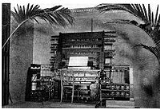
Electronic music
Overview
Electronic music is music that employs electronic musical instrument
s and electronic
music technology
in its production. In general a distinction can be made between sound produced using electromechanical means and that produced using electronic technology. Examples of electromechanical sound producing devices include the telharmonium
, Hammond organ
, and the electric guitar
. Purely electronic sound production can be achieved using devices such as the Theremin
, sound synthesizer
, and computer
.
Electronic music was once associated almost exclusively with Western art music
but from the late 1960s on the availability of affordable music technology meant that music produced using electronic means became increasingly common in the popular domain.
Electronic musical instrument
An electronic musical instrument is a musical instrument that produces its sounds using electronics. Such an instrument sounds by outputting an electrical audio signal that ultimately drives a loudspeaker....
s and electronic
Electronics
Electronics is the branch of science, engineering and technology that deals with electrical circuits involving active electrical components such as vacuum tubes, transistors, diodes and integrated circuits, and associated passive interconnection technologies...
music technology
Music technology
Music technology is a term that refers to all forms of technology involved with the musical arts, particularly the use of electronic devices and computer software to facilitate playback, recording, composition, storage and performance. This subject is taught at many different educational levels,...
in its production. In general a distinction can be made between sound produced using electromechanical means and that produced using electronic technology. Examples of electromechanical sound producing devices include the telharmonium
Telharmonium
The Telharmonium was an early electronic musical instrument, developed by Thaddeus Cahill in 1897. The electrical signal from the Telharmonium was transmitted over wires; it was heard on the receiving end by means of 'horn' speakers.Like the later Hammond organ, the Telharmonium used tonewheels to...
, Hammond organ
Hammond organ
The Hammond organ is an electric organ invented by Laurens Hammond in 1934 and manufactured by the Hammond Organ Company. While the Hammond organ was originally sold to churches as a lower-cost alternative to the wind-driven pipe organ, in the 1960s and 1970s it became a standard keyboard...
, and the electric guitar
Electric guitar
An electric guitar is a guitar that uses the principle of direct electromagnetic induction to convert vibrations of its metal strings into electric audio signals. The signal generated by an electric guitar is too weak to drive a loudspeaker, so it is amplified before sending it to a loudspeaker...
. Purely electronic sound production can be achieved using devices such as the Theremin
Theremin
The theremin , originally known as the aetherphone/etherophone, thereminophone or termenvox/thereminvox is an early electronic musical instrument controlled without discernible physical contact from the player. It is named after its Russian inventor, Professor Léon Theremin, who patented the device...
, sound synthesizer
Synthesizer
A synthesizer is an electronic instrument capable of producing sounds by generating electrical signals of different frequencies. These electrical signals are played through a loudspeaker or set of headphones...
, and computer
Computer
A computer is a programmable machine designed to sequentially and automatically carry out a sequence of arithmetic or logical operations. The particular sequence of operations can be changed readily, allowing the computer to solve more than one kind of problem...
.
Electronic music was once associated almost exclusively with Western art music
Art music
Art music is an umbrella term used to refer to musical traditions implying advanced structural and theoretical considerations and a written musical tradition...
but from the late 1960s on the availability of affordable music technology meant that music produced using electronic means became increasingly common in the popular domain.

